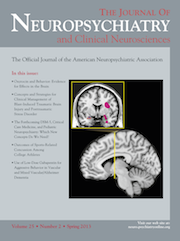Is Attention Deficit Hyperactivity Disorder a Kind of Intermittent Chaos?
To the Editor: It has been shown that chaos plays an essential role in neural systems analysis.1 Chaotic systems are nonlinear, complex systems sensitive to initial conditions. The periodic windows are parts of a chaotic system’s dynamic in which changes in system parameters make a sudden alteration in system’s behavior from chaotic to periodic. Just around each periodic window, the system behavior is intermittent. Intermittency can be defined as a kind of wandering behavior between two or more (here, periodic and chaotic) behavior. In this mode, although the system shows periodicity in parts of time, it cannot lock onto this behavior; therefore, the behavior of the system will switch to chaotic again.2
Previous studies show that when the human brain is in attention mode, the common chaotic behavior of the brain transforms to a more ordered and periodic manner.3 This is consistent with self-experience during attention, in which we try to order confused thoughts.
In a previous work,4 we suggested that attention can be modeled as a periodic window. Some attention-deficit hyperactivity disorder (ADHD) symptoms are difficulty in maintaining attention on one subject and frequent switching from one activity to another.5 It seems that these behaviors are similar to intermittent chaos. A chaotic system at the intermittency situation shows erratic behavior2 that is similar to the disorganized mind’s behavior in people with attention deficit. ADHD patients have also difficulty in keeping their attention on a task and, similarly, at intermittency, the chaotic system cannot preserve its periodic manner, and switches to chaos. Therefore, the idea comes to mind that intermittency regions of chaotic systems can be used to model ADHD. Closer analysis of this idea, especially, chaotic analysis of the electroencephalogram (EEG) signals of patients in normal and long attention mode seems to be valuable. This model may be useful for better understanding of ADHD. We suggest that using control methods of intermittency6 may be valuable in finding some solutions to improve attention-deficit disorder.
1 : Is there chaos in the brain? II: experimental evidence and related models. C R Biol 2003; 326:787–840Crossref, Medline, Google Scholar
2. Hilborn RC: Chaos and Nonlinear Dynamics, 2nd Edition. New York, Oxford University Press, Inc., 2000Google Scholar
3 : The physiology of perception. Sci Am 1991; 264:78–85Crossref, Medline, Google Scholar
4 Jafari S, Ansari Z, Hashemi Golpayegani SMR, et al: Is attention a “period window” in the chaotic brain? J Neuropsychiatry Clin Neurosci Winter 2013; [E-pub]; E5Google Scholar
5 : What Causes ADHD? Understanding What Goes Wrong and Why. New York, Guilford, 2006Google Scholar
6 : Control of crisis-induced intermittency in the dynamics of a kicked, damped spin. Phys Rev E Stat Phys Plasmas Fluids Relat Interdiscip Topics 1996; 55:5044–5049Google Scholar



